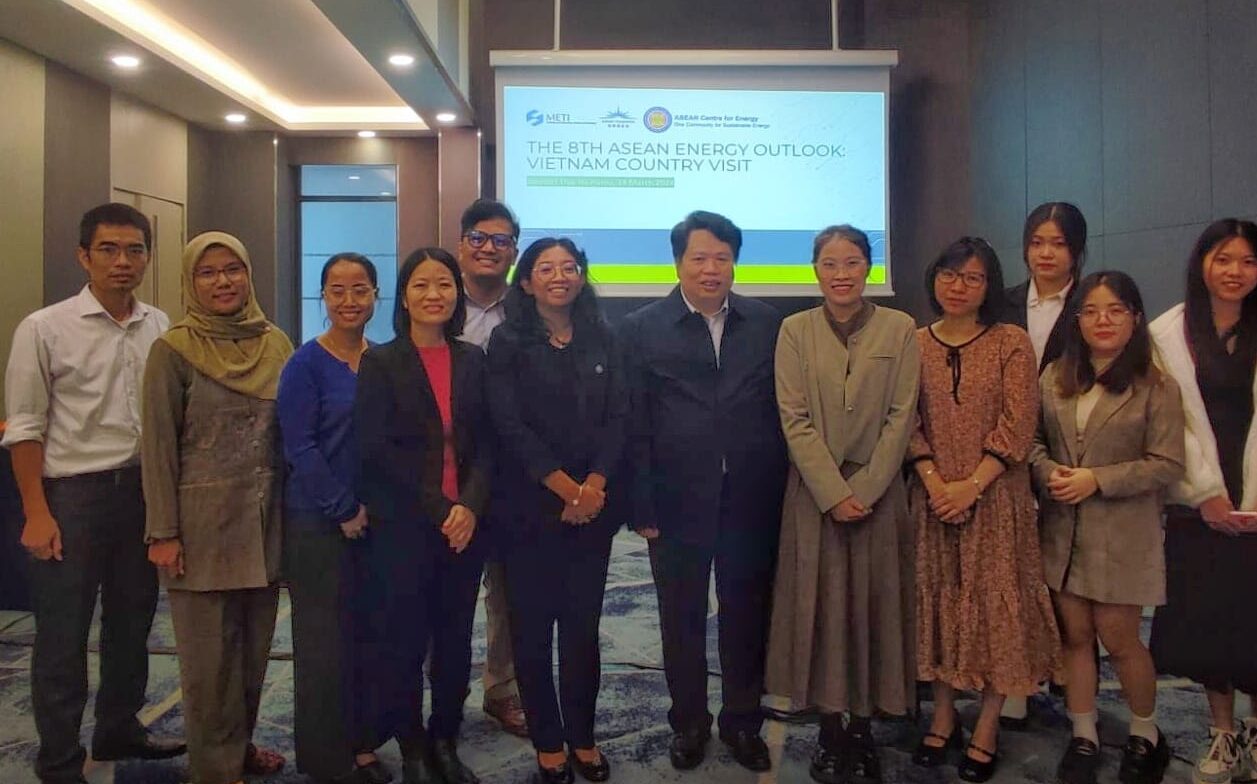Menu

Photo 1. AEO8 Team with Vietnam Representatives During Country Visit to Viet Nam
After the first 8th ASEAN Energy Outlook (AEO8) Workshop was conducted in Indonesia last November, the ASEAN Center for Energy (ACE) is visiting ten ASEAN Member States (AMS) to share and consult on the initial modelling results from January until March 2024. On 14 March, 2024, ACE conducted the AEO8 Country Visit to Viet Nam, the last consultation of the series. During these visits, ACE invites energy officials and relevant stakeholders from AMS to gain additional input and check for the modelling, such as detailed data, assumptions, and initial findings.
Joined by the representatives from the Ministry of Industry and Trade (MOIT) and some universities in Hanoi, the event started with a progress update on AEO8, presented by Rika Safrina, Senior Analyst of the Energy Modelling and Policy Planning (MPP) at ACE. The presentation showed the overview of the four scenarios to be applied and the planned outline of the AEO8 Report that will be launched in September 2024 during the 42nd ASEAN Ministers on Energy Meeting (AMEM) in Vientiane, Lao PDR. The report draft is expected to be reviewed through a quadruple-helix approach, involving government, community, industry, and academia.
As the next ASEAN Plan of Action for Energy Cooperation (APAEC) is due to begin its cycle of 2026-2030, the country visit offers an opportunity for ACE to gather input on the priorities and targets that member states may see implemented in the future. The discussion was also led by Rika Safrina. From the session, it is concluded that Viet Nam’s energy priorities for the future are energy security and sustainability, as well as low-carbon energy. Viet Nam also remarked that the future potential technology used in Viet Nam will be dependent on the availability of resources and capacity. ACE also gathered input regarding the different program areas and the various energy sources for the future. All the input will be taken into account, along with inputs from other member states for the regional energy themes and objectives under APAEC 2026-2030.

Photo 2. Discussion with Viet Nam Representatives
Following the APAEC discussions, a quick demonstration of LEAP was given by Michael Petalio, Energy Modeller at ACE. LEAP is one of the software used for modelling needs in AEO8. The demonstration allowed representatives to see how the results of AEO8 were achieved and how the data provided by Viet Nam to ACE was used. This also gave a chance for any issues or concerns to be addressed for future modelling. Viet Nam representatives were interested in learning LEAP more from ACE experts.
The afternoon session commenced with a data discussion led by Silvira Ayu Rosalia, Energy Statistician and Data Visualisation Officer at ACE. This discussion focuses on the data and policies that will be used for AEO8 modelling. Specifically, it reviews the information received by ACE from Viet Nam focal points and the one collected from external sources for unavailable data. Vietnamese participants highlighted the policies under the National Green Growth Strategy for 2021-2030, a vision towards 2050.
The last agenda for this country visit was a presentation about the initial findings of the Baseline Scenario and AMS Target Scenario (ATS), prepared by Michael Petalio. This session reviews the assumptions and projected growth of energy demand and supply, as well as the future capacity and technology currently included in the model. Viet Nam detailed the disaggregated targets of each industry, enabling more detailed and accurate energy modelling. One concern that Viet Nam addressed was the need for some technologies to be higher due to targets set out by specific policies. Viet Nam also addressed limiting the added capacity in the initial forecasted years due to the unrealistic results since any added energy capacity for closer years would require construction and not instant additions.
—
AEO8 development is supported by several partners, including the Ministry of Economy, Trade and Industry (METI) Japan, the Norwegian Government through the ASEAN Climate Change and Energy Project (ACCEPT) Phase II, the USAID through Smart Power Programme (SPP), Australian Government through Partnerships for Infrastructure (P4I), Energy Foundation China, and many technical partners.
